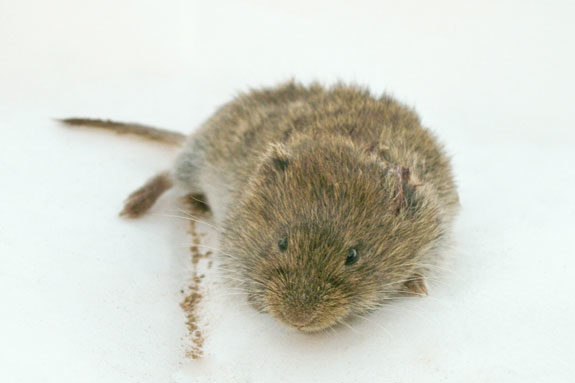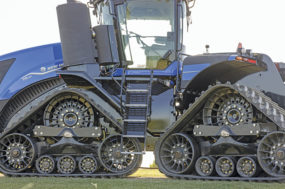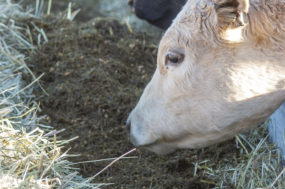Hypotheses for increased populations take into account the mild winters and wet springs in 2009 and 2010 that produced an abundance of forage.
High acreages of CRP lands and public grazing issues are also contributing factors. If these conditions remain static, populations will continue to increase.Voles have remarkable reproductive capacity, which further amplifies problems associated with these rodents.
Population surges can occur frequently when adequate forage and habitat are readily available. Forage losses from voles have been estimated at 10 to 50 percent in pastures and alfalfa.
Economic losses can be severe but are often not quantified.
Voles are non-game mammals in most states and can be legally managed on private property and public lands.
Management options depend endangered species considerations, laws, cost limitations and availability of equipment and labor.
Since voles can cause substantial economic losses, it is important to understand their biology and habits before implementing management strategies.
Biology
Twenty-three species of voles exist in the United States. It can be difficult to distinguish among them. The meadow vole (Microtus pennsylvanicus), is one of the most common species found in pastures, rangelands and crops.
Meadow voles are heavy-bodied, small rodents with short legs and tails, small rounded ears and coarse blackish to grayish-brown fur with black-tipped hairs and bi-colored tails.
Voles generally average 4.5 to 5.5 inches long, including the tail, when full grown.
Voles can reproduce year-round with a peak breeding period in the spring followed by a second, smaller period in the fall.
Females can reach reproductive maturity in 35 to 40 days. They average one to five litters per year with three to six young per litter. Gestation is approximately 21 days.
Vole populations are cyclic and can fluctuate dramatically from year to year. Since populations are partially controlled by predators, most years, voles are not a significant problem.
If habitat is abundant and provides protection from predators, high-protein food sources exist and weather conditions are ideal, vole populations can quickly reach damaging levels.
Minor peak populations occur approximately every four to six years. Epidemic populations occur about every 10 to 12 years and may last a year or more before the population crashes.
These events can result in infestations of 400 voles or more per acre.
Behavior
Most damage caused by voles is the result of their feeding activity. Voles can weigh 3 to 4.5 ounces and can eat nearly their own bodyweight daily.
Voles damage crops by feeding on roots and stems, grass and seeds. Voles have a home range of approximately 0.25 acre or more.
Voles are active all year, especially in the spring and fall. They are most active at night, but can also be seen during the day.
Voles are normally found in areas of dense groundcover. Vegetation greater than six inches in height, snow cover, brush piles, leaves and low-hanging tree limbs all provide excellent protection from predators.
Voles do not like crossing bare ground and prefer cover when feeding. Feeding activity can easily be recognized by the presence of shallow tunnels and runways in vegetation and by underground nests of grass, stems and leaves.
Runways are approximately one to two inches wide with an entrance hole leading underground. Frequently used runways may have grass and other nearby vegetation clipped very close to the ground.
Feces and small pieces of clipped vegetation are usually found in runways. Voles seldom stray from their usual routes.
Management
Areas subject to vole invasion should be routinely monitored for signs of feeding activity from early spring until late fall. If possible, monitor for signs in the winter.
Vole signs can be identified year-round. Runways, feces, clipped forage, gnawed stems, bark and roots, and tunnels are all signs of possible vole activity.
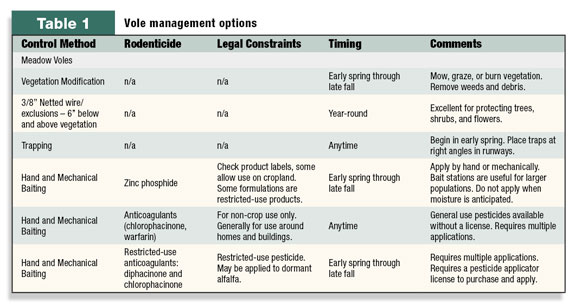
Table 1 provides a summary of various control measures to help manage damaging vole populations.
• Predators
Owls, hawks, snakes, cats and dogs, among others, utilize voles as a food source.
Relying on predator control will not keep vole populations at an acceptable level to minimize or eliminate damage.
• Habitat modification
Habitat modification and population reduction strategies will prevent large population increases.
Methods include the following:
1. mowing, burning ditch banks, barrow pits and fencelines
2. clearing weeds and debris from windbreaks and other affected areas
3. developing weed-free cultivated buffer strips around cropland
4. grazing or mowing in late fall when active plant growth is not taking place to reduce habitat and food sources
5. constructing aluminum flashing or other materials to serve as entry barriers
6. light tillage and annual cropping
• Trapping
Where allowed by state law, this control method is best utilized in small areas. It is not effective or practical for large infestations.
Simple wooden mousetraps can be used. Trap placement is crucial for optimum success. Place traps at right angles to and flush with the ground in surface runways. Always attach a small chain to the trap or predators will drag the vole and trap off.
Bait is generally not needed because voles will trip traps during normal activity. If desired, traps can be baited with peanut butter, oatmeal or apple slices.
To avoid potential bait loss, mix peanut butter with cotton wool or cotton balls and clamp into the tripping mechanism of the trap.
Examine traps daily and remove and bury dead voles. Like all rodents, voles can carry diseases, bacteria and other organisms that can be harmful to human health, so do not handle voles without gloves.
• Baiting
Normally, voles are not particularly bait-shy. Always use fresh bait products. Old bait products may have an off odor or could be moldy or damaged.
If voles are not consuming bait products, pre-baiting with non-toxic bait that is the same size, shape and formulation as the toxic bait may be used to increase bait consumption. Once voles are used to consuming the non-toxic bait, change to toxic bait.
When using toxic baits, caution must be used around children, pets and non-target animals. Pick up any spilled bait and dispose of according to the label.
Dispose of dead voles and bait that may escape the trap so there is no chance of poisoning pets, livestock or wildlife.
Carefully read and follow all label instructions before applying bait. Before using bait, check with your state department of agriculture to receive a list of approved baits for your area.
Rodenticide baits may pose a hazard to federally designated endangered or threatened species and may not be used in any manner that results in their death or harm.
Extensive endangered species information may not always be listed on the label. Check the Environmental Protection Agency’s endangered species bulletins online for restrictions regarding the use of rodenticides in areas these species may or are known to inhabit.
Bait: Zinc phosphide
Zinc phosphide can be sold under trade names such as Prozap® and ZP AG®. Some zinc phosphide products are combined with grains, while others are in pellet form.
Some zinc phosphide products are restricted-use pesticides and require a pesticide applicator license to purchase and use.
These products include those labeled for agricultural crops such as wheat, barley, alfalfa, potatoes, sugar beets, grape vineyards, orchards, and nursery stock.
These products can be broadcast on the target site. Before purchasing, check the label carefully to be sure the product can be used on the target site and crop.
Other zinc phosphide products are general-use pesticides and do not require a pesticide applicator license. These products can be purchased by consumers in packages of one pound or less.
When allowed by the label, these products can be used in turf, lawns and other noncrop areas. They can be placed in runways, in or next to burrows, or mechanically broadcast in infested areas.
In many areas, bait spreaders are available for rental. It is a good practice to place zinc phosphide in a bait station to keep it out of reach of children and non-target animals.
Be sure to keep zinc phosphide from getting wet. Moisture activates the chemical, rendering it ineffective very quickly.
Zinc phosphide acts rapidly, and a single feeding is generally lethal to voles within 12 hours. In rare cases, voles may survive and become bait- shy.
For this reason, zinc phosphide should not be used in the same field more than once in a 6-month period.
Zinc phosphide converts to phosphine gas when it is ingested by a vole, causing death. It does not accumulate in the vole’s body tissues.
Therefore, predators or scavengers such as dogs or cats are not likely to be affected by eating poisoned rodents. However, children, pets, birds, and other animals can be affected by direct contact with the bait.
Store bait out of reach and use it carefully to minimize unintended access.
Bait: Anticoagulants
Anticoagulants are classified as first- and second-generation products. First-generation anticoagulants require multiple feedings by the rodent before a lethal dose is ingested.
Examples of these products include Warfarin, Diphacinone and Chlorophacinone. These products can be used for home and residential use, but should be used with a tamper- resistant bait station.
Second-generation products are single-feed products and are not allowed to be sold in grocery, drug, hardware or home improvement stores for home and residential use.
Second-generation products will have one of the following active ingredients: Brodifacoum, Bromadiolone, Difenacoum and Difethialone. Products containing these active ingredients are restricted to professional, farm, ranch and facility use.
Information provided regarding first- and second-generation products will be effective June 4, 2011 and after existing stocks are sold in accordance with EPA’s Rodenticide Risk Management Decision, dated June 4, 2008.
Anticoagulant baits are formulated using grain or other food sources that will attract rodents. These baits are usually in the form of pellets and blocks.
Some are coated in paraffin to provide moisture resistance. Paraffin-coated baits are useful around ditches and other areas where moisture may cause other types of baits to spoil and lose potency.
Anticoagulant baits cannot be applied directly to food or feed crops. To avoid contact with a growing crop, these baits are used in areas adjacent to crop fields, in orchards after fruits or nuts are harvested or during crop dormancy.
Before purchasing any product, check the label to be sure it can be used on the target site.
Diphacinone bait products (Ramik Brown® and Kaput-D®) are restricted-use pesticides available only to those who have a current pesticide applicator license.
These products can be used in fruit and nut orchards, tree nurseries and tree farms, but cannot be applied directly to food or feed crops.
Another restricted-use pesticide is Rozol® Vole Bait (chlorophacinone). It can be used in non-crop areas, lawns, turf, ornamental flower and shrub plantings, orchards, nurseries, and tree and forestry plantations.
General-use anticoagulant pesticides include another formulation of chlorophacinone (Rozol® pellets) and warfarin (Kaput®, Rodex®). These products can be used by the general public. They are intended for use around homes and buildings.
All anticoagulant baits are toxic to animals; take precautions to prevent non-target animals from consuming the bait. Carefully read and follow the precautionary statements on the pesticide label. Bait must be used at the specific target site as indicated on the label.
Bait stations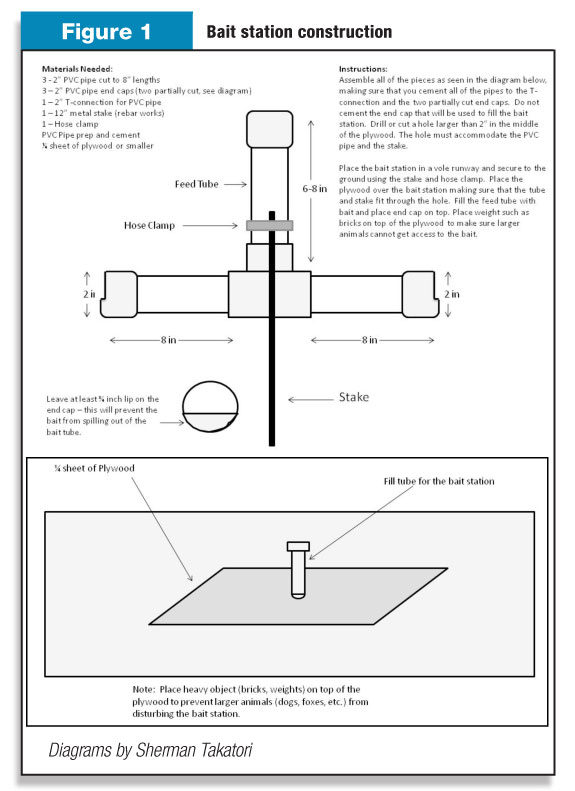
Figure 1 illustrates a simple PVC pipe bait station. The plywood cover provides an area voles will go to that is protected from predators or raptors, keeps bait dry so it does not lose effectiveness and prevents access by children, birds, pets and other animals.
Although Figure 1 suggests a quarter sheet of plywood, any sturdy covering, such as tarps, canvases, disc harrow blades or metal roofing material will suffice.
When using this type of bait station in turf, it is important to regularly move the bait station so turf is not significantly damaged. Place bait station(s) on the edges of turf where the most significant activity is apparent.
For range and pastures, lengthen the feeding tube to at least 12 inches and stake the bait station to the ground.
The longer tube holds more bait since these stations cannot be monitored as often as those in lawns and gardens, and reduces bait spillage.
In these areas, bait stations do not need to be covered since pets and children are not likely to be present and good vegetative cover will encourage voles to visit the bait station.
However, if safety is a concern, use a durable type of covering over the bait station. The cover will prevent non-target poisoning and deter other animals from damaging the bait station.
Disclaimer
Always read and follow the instructions printed on the pesticide label. The pesticide recommendations in this article do not substitute for instructions on the label.
Pesticide laws and labels change frequently and may have changed since this information was written. Some pesticides may have been withdrawn or had certain uses prohibited.
Use pesticides with care. Do not use a pesticide unless the specific plant, animal or other application site is specifically listed on the label.
Store pesticides in their original containers and keep them out of the reach of children, pets, and livestock.
To simplify information, trade names have been used. No endorsement of named products is intended nor is criticism implied of similar products not mentioned.
To protect groundwater, when there is a choice of pesticides, the applicator should use the product least likely to leach. FG
D. Gunn, R. Hirnyck, G. Shewmaker, and L. Ellis are with the University of Idaho and S. Takatori is with the Idaho State Department of Agriculture.
